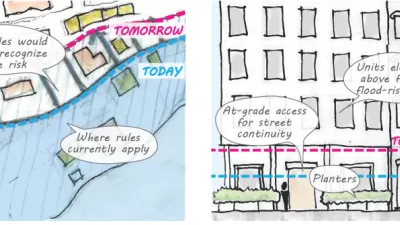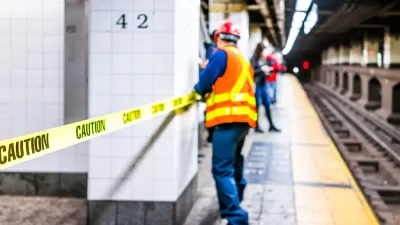New York's chief urban designer, Alexandros Washburn, addresses the monumental task of rebuilding New York after Hurricane Sandy and preparing for the next storm.
In October 2012, as Hurricane Sandy approached New York, Alexandros Washburn defied evacuation orders and stayed fast in his home in Red Hook, watching as his street flooded and became a "full-fledged river." But he had good reason; the city's chief urban designer wanted to observe first-hand "the dynamics of the storm surge and its effect on our streets and structures."
In an excerpt on Places from his new book The Nature of Urban Design, Washburn recounts his experience during the storm and the hugely complicated — and ongoing — municipal recovery and response. Like average citizens, he's tangled up in the bureacracy of rebuilding: "For weeks I have been working on plans to rebuild the ground floor of my house. It’s frustrating; the rules keep changing. A couple of months ago, the mayor issued an executive order mandating higher levels for rebuilding. Then the federal government issued a new set of 'advisory base flood elevations.' Now those are rumored to be changing, too. The new flood height is almost five feet above my ground floor. I’m as confounded as my neighbor: What do I do?"
FULL STORY: Resilience in Red Hook

Alabama: Trump Terminates Settlements for Black Communities Harmed By Raw Sewage
Trump deemed the landmark civil rights agreement “illegal DEI and environmental justice policy.”

Planetizen Federal Action Tracker
A weekly monitor of how Trump’s orders and actions are impacting planners and planning in America.

The 120 Year Old Tiny Home Villages That Sheltered San Francisco’s Earthquake Refugees
More than a century ago, San Francisco mobilized to house thousands of residents displaced by the 1906 earthquake. Could their strategy offer a model for the present?

Indy Neighborhood Group Builds Temporary Multi-Use Path
Community members, aided in part by funding from the city, repurposed a vehicle lane to create a protected bike and pedestrian path for the summer season.

Congestion Pricing Drops Holland Tunnel Delays by 65 Percent
New York City’s contentious tolling program has yielded improved traffic and roughly $100 million in revenue for the MTA.

In Both Crashes and Crime, Public Transportation is Far Safer than Driving
Contrary to popular assumptions, public transportation has far lower crash and crime rates than automobile travel. For safer communities, improve and encourage transit travel.
Urban Design for Planners 1: Software Tools
This six-course series explores essential urban design concepts using open source software and equips planners with the tools they need to participate fully in the urban design process.
Planning for Universal Design
Learn the tools for implementing Universal Design in planning regulations.
Clanton & Associates, Inc.
Jessamine County Fiscal Court
Institute for Housing and Urban Development Studies (IHS)
City of Grandview
Harvard GSD Executive Education
Toledo-Lucas County Plan Commissions
Salt Lake City
NYU Wagner Graduate School of Public Service





























